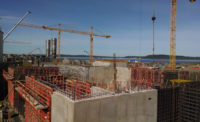The Brightwater wastewater treatment plant near Seattle is nearing completion. Although the job is a year late and carries more than $200 million in disputed claims, for the most part, Washington state's King County officials are pleased with the project.
The $1.8-billion project includes 13 miles of deep-bore conveyance, ranging below the surface from 40 ft to 440 ft, as well as four portals and a pump station to a Puget Sound marine outflow station.
The project started off routinely enough in 2005, but a failed tunnel-boring machine caused delays. With the mining on the tunnel finally completed this past August—nearly a year late—and the new treatment plant opening in September 2011, the entire project will now open in late summer 2012, says Gunars Sreibers, the King County Wastewater Treatment Division project manager.
In 2007, working under a $211-million contract, the joint venture Vinci-Parsons-Frontier-Kemper (VPFK), Kenmore, Wash., dropped two tunnel-boring machines into the central tunnel, one running west and one running east. The hiccup came when the west-driving TBM got stuck in the central portion of the project, with 1.9 miles of a six-mile shaft remaining. The eastbound portion completed without a major mishap, but, by 2009, the county required schedule changes to get the western portion on track for a November 2010 completion.
However, when VPFK then dedicated both tunnel-boring machines to finishing the western tunnel, both TBMs broke down and sat idle for nine months. Locked in litigation with VPFK, King County, in April 2010, turned to the joint venture Jay Dee-Coluccio—two-thirds of the Seattle-based Jay Dee-Coluccio-Taisei team that, under a $102 million contract, finished the four-mile tunnel directly to the west—to complete VPFK's mining work.
“Their machine just happened to be available at the right location,” Sreibers says. “The biggest challenge was to get that contract in place. We wrote an almost $70-million contract in less than three months' time. And, on top of that, the TBM had already mined 21,000 ft. We wanted to make sure before it embarked on the last 10,000 ft [that] it was in really good shape.”
Gregory Hauser, project manager for Jay Dee-Coluccio, says getting TBM “Elizabeth” in shape for a second—and unplanned—job proved more daunting than he anticipated. “We started winding down off [the west tunnel],” he says. “We were all but done, and I was giving people away to other projects. It was pretty involved [to resume work].”
While Jay Dee-Coluccio finished mining, VPFK dismantled its machines and capped the end of the tunnel with a 14-ft-thick concrete plug. The final portion was mined in August.
Although VPFK and King County are suing each other in court for $206 million in costs, Sreibers says, VPFK is still responsible for installing the lining and piping.
The change in TBMs also caused a $2.4-million mix-up, as VPFK's TBM “Rainier” bore diameter is 14.4 ft and Elizabeth's is 13 ft. Custom-made concrete liners were discarded, and the wasted expense remains an issue in the legal battle.



Post a comment to this article
Report Abusive Comment